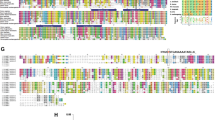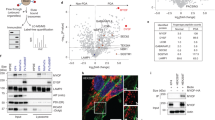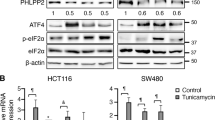Abstract
Signal peptide peptidase (SPP) is an endoplasmic reticulum (ER)-resident aspartyl protease mediating intramembrane cleavage of type II transmembrane proteins. Increasing evidence has supported the role of SPP in ER-associated protein degradation. In the present study, we show that SPP expression is highly induced in human lung and breast cancers and correlated with disease outcome. Stable depletion of SPP expression in lung and breast cancer cell lines significantly reduced cell growth and migration/invasion abilities. Quantitative analysis of the proteomic changes of microsomal proteins in lung cancer cells by the stable isotope labeling with amino acids in cell culture (SILAC) approach revealed that the level of FKBP8, an endogenous inhibitor of mTOR, was significantly increased following SPP depletion. Co-immunoprecipitation assay and confocal immunofluorescence demonstrated that SPP interacted and colocalized with FKBP8 in ER, supporting that FKBP8 is a protein substrate of SPP. Cycloheximide chase and proteasome inhibition experiments revealed that SPP-mediated proteolysis facilitated FKBP8 protein degradation in cytosol. Further experiment demonstrated that the levels of phosphorylation in mTOR and its downstream effectors, S6K and 4E-BP1, were significantly lower in SPP-depleted cells. The reduced mTOR signaling and decreases of growth and migration/invasion abilities induced by SPP depletion in cancer cells could be reversed by FKBP8 downregulation. The implication of FKBP8 in SPP-mediated tumorigenicity was also observed in the xenograft model. Together, these findings disclose that SPP promotes tumor progression, at least in part, via facilitating the degradation of FKBP8 to enhance mTOR signaling.
This is a preview of subscription content, access via your institution
Access options
Subscribe to this journal
Receive 50 print issues and online access
$259.00 per year
only $5.18 per issue
Buy this article
- Purchase on Springer Link
- Instant access to full article PDF
Prices may be subject to local taxes which are calculated during checkout








Similar content being viewed by others
References
Brown MS, Ye J, Rawson RB, Goldstein JL. Regulated intramembrane proteolysis: a control mechanism conserved from bacteria to humans. Cell. 2000;100:391–8.
Urban S, Freeman M. Intramembrane proteolysis controls diverse signalling pathways throughout evolution. Curr Opin Genet Dev. 2002;12:512–8.
Wolfe MS. Intramembrane-cleaving proteases. J Biol Chem. 2009;284:13969–73.
Weihofen A, Binns K, Lemberg MK, Ashman K, Martoglio B. Identification of signal peptide peptidase, a presenilin-type aspartic protease. Science. 2002;296:2215–8.
Voss M, Schroder B, Fluhrer R. Mechanism, specificity, and physiology of signal peptide peptidase (SPP) and SPP-like proteases. Biochim Biophys Acta. 2013;1828:2828–39.
Lemberg MK, Martoglio B. Requirements for signal peptide peptidase-catalyzed intramembrane proteolysis. Mol Cell. 2002;10:735–44.
Okamoto K, Moriishi K, Miyamura T, Matsuura Y. Intramembrane proteolysis and endoplasmic reticulum retention of hepatitis C virus core protein. J Virol. 2004;78:6370–80.
Targett-Adams P, Schaller T, Hope G, Lanford RE, Lemon SM, Martin A, et al. Signal peptide peptidase cleavage of GB virus B core protein is required for productive infection in vivo. J Biol Chem. 2006;281:29221–7.
Shi X, Botting CH, Li P, Niglas M, Brennan B, Shirran SL, et al. Bunyamwera orthobunyavirus glycoprotein precursor is processed by cellular signal peptidase and signal peptide peptidase. Proc Natl Acad Sci USA. 2016;113:8825–30.
Avci D, Lemberg MK. Clipping or extracting: two ways to membrane protein degradation. Trends Cell Biol. 2015;25:611–22.
Mentrup T, Fluhrer R, Schroder B. Latest emerging functions of SPP/SPPL intramembrane proteases. Eur J Cell Biol. 2017;96:372–82.
Loureiro J, Lilley BN, Spooner E, Noriega V, Tortorella D, Ploegh HL. Signal peptide peptidase is required for dislocation from the endoplasmic reticulum. Nature. 2006;441:894–7.
Hsu FF, Yeh CT, Sun YJ, Chiang MT, Lan WM, Li FA, et al. Signal peptide peptidase-mediated nuclear localization of heme oxygenase-1 promotes cancer cell proliferation and invasion independent of its enzymatic activity. Oncogene. 2015;34:2360–70.
Boname JM, Bloor S, Wandel MP, Nathan JA, Antrobus R, Dingwell KS, et al. Cleavage by signal peptide peptidase is required for the degradation of selected tail-anchored proteins. J Cell Biol. 2014;205:847–62.
Chen CY, Malchus NS, Hehn B, Stelzer W, Avci D, Langosch D, et al. Signal peptide peptidase functions in ERAD to cleave the unfolded protein response regulator XBP1u. EMBO J. 2014;33:2492–506.
Avci D, Fuchs S, Schrul B, Fukumori A, Breker M, Frumkin I, et al. The yeast ER-intramembrane protease Ypf1 refines nutrient sensing by regulating transporter abundance. Mol Cell. 2014;56:630–40.
Bai X, Ma D, Liu A, Shen X, Wang QJ, Liu Y, et al. Rheb activates mTOR by antagonizing its endogenous inhibitor, FKBP38. Science. 2007;318:977–80.
Chen X, Wei S, Ji Y, Guo X, Yang F. Quantitative proteomics using SILAC: principles, applications, and developments. Proteomics. 2015;15:3175–92.
Lam E, Martin M, Wiederrecht G. Isolation of a cDNA encoding a novel human FK506-binding protein homolog containing leucine zipper and tetratricopeptide repeat motifs. Gene. 1995;160:297–302.
Shirane M, Nakayama KI. Inherent calcineurin inhibitor FKBP38 targets Bcl-2 to mitochondria and inhibits apoptosis. Nat Cell Biol. 2003;5:28–37.
Edlich F, Weiwad M, Erdmann F, Fanghanel J, Jarczowski F, Rahfeld JU, et al. Bcl-2 regulator FKBP38 is activated by Ca2+/calmodulin. EMBO J. 2005;24:2688–99.
Das I, Craig C, Funahashi Y, Jung KM, Kim TW, Byers R, et al. Notch oncoproteins depend on gamma-secretase/presenilin activity for processing and function. J Biol Chem. 2004;279:30771–80.
Murakami D, Okamoto I, Nagano O, Kawano Y, Tomita T, Iwatsubo T, et al. Presenilin-dependent gamma-secretase activity mediates the intramembranous cleavage of CD44. Oncogene. 2003;22:1511–6.
Cespedes MV, Larriba MJ, Pavon MA, Alamo P, Casanova I, Parreno M, et al. Site-dependent E-cadherin cleavage and nuclear translocation in a metastatic colorectal cancer model. Am J Pathol. 2010;177:2067–79.
Guan M, Su L, Yuan YC, Li H, Chow WA. Nelfinavir and nelfinavir analogs block site-2 protease cleavage to inhibit castration-resistant prostate cancer. Sci Rep. 2015;5:9698.
Song W, Liu W, Zhao H, Li S, Guan X, Ying J, et al. Rhomboid domain containing 1 promotes colorectal cancer growth through activation of the EGFR signalling pathway. Nat Commun. 2015;6:8022.
Wahlstrom AM, Cutts BA, Karlsson C, Andersson KM, Liu M, Sjogren AK, et al. Rce1 deficiency accelerates the development of K-RAS-induced myeloproliferative disease. Blood. 2007;109:763–8.
Fong S, Mounkes L, Liu Y, Maibaum M, Alonzo E, Desprez PY, et al. Functional identification of distinct sets of antitumor activities mediated by the FKBP gene family. Proc Natl Acad Sci USA. 2003;100:14253–8.
Choi MS, Min SH, Jung H, Lee JD, Lee TH, Lee HK, et al. The essential role of FKBP38 in regulating phosphatase of regenerating liver 3 (PRL-3) protein stability. Biochem Biophys Res Commun. 2011;406:305–9.
Barth S, Edlich F, Berchner-Pfannschmidt U, Gneuss S, Jahreis G, Hasgall PA, et al. Hypoxia-inducible factor prolyl-4-hydroxylase PHD2 protein abundance depends on integral membrane anchoring of FKBP38. J Biol Chem. 2009;284:23046–58.
Wei JW, Cai JQ, Fang C, Tan YL, Huang K, Yang C, et al. Signal peptide peptidase, encoded by HM13, contributes to tumor progression by affecting EGFRvIII secretion profiles in glioblastoma. CNS Neurosci Ther. 2017;23:257–65.
Hwang HW, Lee JR, Chou KY, Suen CS, Hwang MJ, Chen C, et al. Oligomerization is crucial for the stability and function of heme oxygenase-1 in the endoplasmic reticulum. J Biol Chem. 2009;284:22672–9.
Acknowledgements
This work was supported by the Ministry of Science and Technology Taiwan (MOST 103-2320-B-001-013-MY3) and Institute of Biomedical Sciences, Academia Sinica.
Author information
Authors and Affiliations
Corresponding author
Ethics declarations
Conflict of interest
The authors declare that they have no conflict of interest.
Electronic supplementary material
Rights and permissions
About this article
Cite this article
Hsu, FF., Chou, YT., Chiang, MT. et al. Signal peptide peptidase promotes tumor progression via facilitating FKBP8 degradation. Oncogene 38, 1688–1701 (2019). https://doi.org/10.1038/s41388-018-0539-y
Received:
Revised:
Accepted:
Published:
Issue Date:
DOI: https://doi.org/10.1038/s41388-018-0539-y
This article is cited by
-
Proteomic analysis of the effect of hemin in breast cancer
Scientific Reports (2023)
-
Histocompatibility Minor 13 (HM13), targeted by miR-760, exerts oncogenic role in breast cancer by suppressing autophagy and activating PI3K-AKT-mTOR pathway
Cell Death & Disease (2022)
-
FKBP10 promotes proliferation of glioma cells via activating AKT-CREB-PCNA axis
Journal of Biomedical Science (2021)
-
Knockdown of GTF2E2 inhibits the growth and progression of lung adenocarcinoma via RPS4X in vitro and in vivo
Cancer Cell International (2021)
-
Prohibitin regulates mTOR pathway via interaction with FKBP8
Frontiers of Medicine (2021)



